Argentine Ants
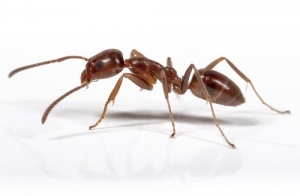 Origin: Thought to have arrived from Brazil in ships transporting coffee around 1891, and now found throughout North America, in Hawaii, and on most other continents throughout the world.
Origin: Thought to have arrived from Brazil in ships transporting coffee around 1891, and now found throughout North America, in Hawaii, and on most other continents throughout the world.
Biology: Though the Argentine Ant is a small, non-stinging ant, it is a very territorial and aggressive ant that will drive away or kill competing ant species. Neighboring colonies of Argentine ants appear not to be aggressive toward each other, allowing for the rapid spread and domination by this species. Colonies contain thousands of workers and many queens, and mating will take place within the confines of the colony. New colonies are often formed by budding off from the parent colony. Nesting is usually in the soil, commonly under concrete slabs, but may also be found in any other convenient void, such as in trees, wall voids, under insulation, or under debris on the soil. Soil nests are generally very shallow. While protein foods are part of their diet, their preferred foods are sugars, including household food products, fruits in gardens, and honeydew.
Bed Bugs
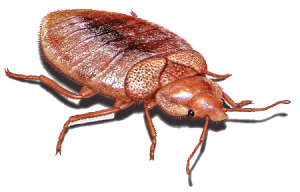 Origin: It is believed that this bug originally evolved with bats living in caves in the Middle East, but in the United States it appears now to be wholly a human pest. It has been associated with humans for thousands of years.
Origin: It is believed that this bug originally evolved with bats living in caves in the Middle East, but in the United States it appears now to be wholly a human pest. It has been associated with humans for thousands of years.
Biology: While this species is not associated with the spread of any diseases, its bite can have a serious effect on people who are sensitive to its saliva, and swelling and severe itching or other immune system reactions may be common. The bite itself is generally painless. The Human bed bug is nocturnal, feeding only at night when people are asleep. During the daylight hours it hides in any available crack or hole in the immediate area. The presence of bedbugs may be determined by an unusual “sweet” odor in the room. Females lay their eggs by gluing them to hidden surfaces, laying several eggs each day with a total of about 200 eggs. There are 5 instar stages to the nymphs, and the growth to the adult stage takes about a month and a half, although in the absence of a blood source the nymph may lay dormant for long periods. The adults can live over a year, and in the absence of human hosts they have been known to feed on birds and rodents.
Black Widow Spider
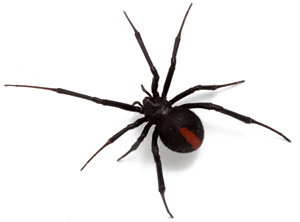 Origin: Five species of these native spiders occur in North America, being found in all states and in southern Canada. Other species may be found worldwide.
Origin: Five species of these native spiders occur in North America, being found in all states and in southern Canada. Other species may be found worldwide.
Biology: The black widow spiders are the most dangerous spiders with respect to human health in the U.S. They are one of the few spiders capable of biting humans that inject a neurotoxin, and the effect of the bite can be serious and potentially fatal. Only females bite humans, but both males and females construct webs to capture other prey, primarily flying insects. Males also enter a female’s web for mating, and if the female is not receptive the male may be eaten. The life span of black widow females averages around 180 days as an adult, taking about 3 months to reach maturity. Males mature in about 70 days and live only about 30 days after that. The female may produce up to 9 egg sacs with about 350 eggs per sac on average. She will be most aggressive and defensive of her webbing while she is guarding these eggs, as well as being more hungry following egg production. The new spiderlings emerge from the sac and remain near it for a day or two, but then they undergo “ballooning” to disperse, creating long silk strands that are carried away by the wind. Black widows are generally reclusive spiders that create their webs in areas of inactivity. The web is made of extremely strong silk that is very sticky, and it has a very haphazard appearance without the symmetry of some other spiders.
Box Elder Bugs
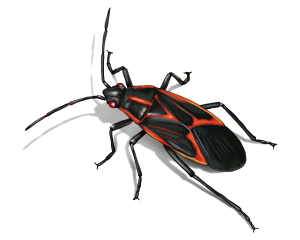 Origin: Native to North America
Origin: Native to North America
Biology: This is the common western variety of the boxelder bug, feeding on various species of maple, ash, box elder, apple, grapes, and many other plants. They feed by inserting their long proboscis into the plant tissues and removing fluids, but are rarely present in such numbers as to cause any problems for the trees. The major issue with the BEB is its annoyance and presence inside structures, where it commonly seeks an over-wintering site and may occur in large numbers. It moves inside in the fall and returns to the outside in the warming months of spring, but often will become active on warm winter days as well, and be seen running around inside. It may attempt to bite if handled, but is not dangerous to people. In the fall the insects begin congregating on walls, fences, and other sunny locations. They then seek entry points to enter the structure where they settle within voids. They will not feed or reproduce indoors, but lay eggs only on the plants outside. Inside, however, they may leave stains from fecal droppings on surfaces, and if crushed will emit the same characteristic odor of other “true” bugs. Females deposit eggs in clusters of about a dozen eggs per placement, for a total of about 250 eggs. Development from egg to adult is about 2 months, and there are two generations per year.
Carpenter Ants
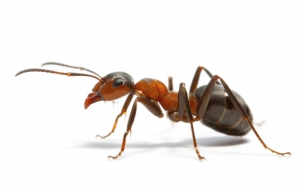 Origin: Many species of these ants are native to North America, with several species seemingly the most likely to invade structural wood members. There are many destructive species in the Pacific Northwest states, as well as from Florida to the northeast to the southwest and in Hawaii.
Origin: Many species of these ants are native to North America, with several species seemingly the most likely to invade structural wood members. There are many destructive species in the Pacific Northwest states, as well as from Florida to the northeast to the southwest and in Hawaii.
Biology: The usual habitat of a colony of carpenter ants is within wood, often wood buried or partially buried in the soil. They also commonly establish “satellite” colonies that may be in a structure, maintaining contact between the two colonies with the workers who travel to and from over well-defined trails. Generally there is a single queen in the colony but often supplementary queens as well. Colonies typically are around 15,000 workers when mature, but potentially could be over 100,000 workers. Foods are both carbohydrates and protein, with insects a major part of the diet. These are single-node ants without a stinger, although they are capable of biting. As they expand their colony they eject “frass”, which is wood chips and other debris such as leftover insect parts. This frass is often seen in structures before the ants are, as they are primarily nocturnal in habit. Carpenter ants are also typically polymorphic, with various sizes of workers in the colony.
Clover Mite
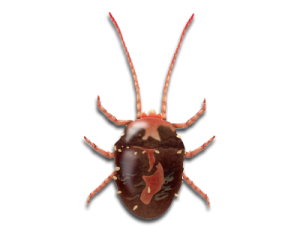 Origin: This is a native species of mite in North America.
Origin: This is a native species of mite in North America.
Biology: The mites in this family are primarily plant parasites, and many of them are serious pests of crops and ornamentals. The clover mite feeds on many kinds of trees, shrubs, bedding plants and turf, but does not bite humans. It becomes a problem when it invades structures in large numbers, especially during warm periods of the year. When crushed they leave small red stains on the surface. No male clover mites have been found, with females reproducing by parthenogenesis. Reproduction is rapid, with hundreds of thousands of mites being produced in a very short time. Eggs are laid in cracks on almost any surface, including trees and the outside of buildings. All stages of the mites may overwinter, although the egg stage is the most common.
Earwig
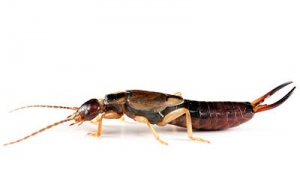 Origin: Probably from Europe or Asia, but this species is now found throughout the world. It was first found in the U.S. around 1907 near Seattle, Washington.
Origin: Probably from Europe or Asia, but this species is now found throughout the world. It was first found in the U.S. around 1907 near Seattle, Washington.
Biology: One of about 7 species of pest earwigs in the U.S., the European Earwig is the most common. It has a simple life cycle, requiring 3 to 5 months to go from egg to adult, depending on temperatures. Adults generally live only about one year. Adults are capable of some flight. Earwigs feed primarily on plant material, but also are predators on many other insects.
Flea
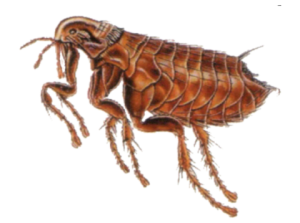 Origin: There are dozens of different species of fleas, but the Cat Flea is by far the most common flea on pets and in structures in the United States. It originated in Africa as an ectoparasite of the large native cats.
Origin: There are dozens of different species of fleas, but the Cat Flea is by far the most common flea on pets and in structures in the United States. It originated in Africa as an ectoparasite of the large native cats.
Biology: The Cat Flea is a blood feeder as the adult, and a scavenger as the larva. The adults remain on the animals they feed on unless physically forced off, and may live up to a year. The female lays the eggs on the host animal and these eggs fall off to the floor or other surface below. The eggs hatch in a few days and the larvae begins to feed on organic debris it finds, but also must consume some dried blood in order to progress to the pupa stage. This blood is from the dried feces of the adult fleas, and it falls off the pets wherever they spend time. Under ideal conditions the time from egg to adult can be as short as 2 weeks, or it may take several months if there is no host activity to stimulate some of the pupa to hatch to the adult stage. The Cat Flea s a possible vector of bubonic plague, and it is a common flea species on raccoons and opossum, as well as the primary flea on both dogs and cats in the U.S.
Hobo Spider
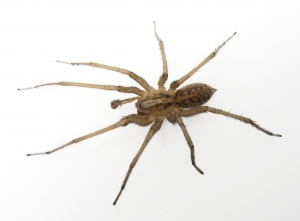 Origin: At least 7 species of spiders in the genus Tegenaria occur in North America, with only T. chiricahuae a native, and occurring in Arizona and New Mexico. The other six species are believed to be European in origin, with T. domestica found throughout the U.S. and T. agrestis found in the Pacific Northwest states. The family contains many other genera and over 400 species of spiders.
Origin: At least 7 species of spiders in the genus Tegenaria occur in North America, with only T. chiricahuae a native, and occurring in Arizona and New Mexico. The other six species are believed to be European in origin, with T. domestica found throughout the U.S. and T. agrestis found in the Pacific Northwest states. The family contains many other genera and over 400 species of spiders.
Biology: The most notorious species in this group is T. agrestis, variously called the Aggressive House Spider or Hobo Spider, and it is known to bite with little provocation. Like many spiders it has venom which is cyto-toxic, and tissue death at the site of the bite, leading to a lingering open wound, is very possible. It is a very common spider in structures in the Pacific Northwest, and is the most likely cause of serious spider bites there. Species of Tegenaria usually live about two years, and with T. agrestis the first year is spent developing to the adult stage, the second summer is for mating and egg production, and the adults die shortly after this. The family name is derived from the prey capture habit of these spiders, which create wide mat of webbing with a funnel-like hole in it, and the spider waits within this funnel for prey to stumble onto the web mat. The spider then rushes out, subdues the prey, and drags it back into the funnel for feeding. The funnel-web mats may be on vegetation or near the soil, or possibly within structures in undisturbed areas.
Honey Bee
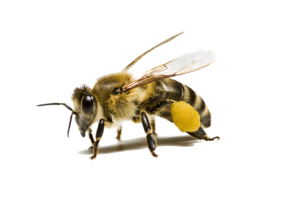 Origin: A native of Europe and Asia, the honeybee was introduced to the United States for honey production and pollination of crops. The Africanized honeybee (a.k.a. “killer bee”) evolved in Africa, was introduced to South America, and found its way north into the U.S.
Origin: A native of Europe and Asia, the honeybee was introduced to the United States for honey production and pollination of crops. The Africanized honeybee (a.k.a. “killer bee”) evolved in Africa, was introduced to South America, and found its way north into the U.S.
Biology: Honeybees are social bees, with colonies composed of a single Queen and many hundreds of workers. New colonies are begun when additional Queens are produced in a colony and all but one leave, each newly fertilized Queen taking a consort of workers with her. Males (drones) are produced only for mating with these new queens, and the males then die. Only the females can sting, but all workers are females and all of the working members of the hive can sting. Honeybees can sting humans only once, losing their stinger in the process. Larvae are fed pollen and honey, and the honey is created by continual mastication and dehydration of the nectar and other sugary fluids the workers gather. Honeybee hives remain active year-round, and often will be located within structures. Queens may live as long as 5 years while workers live less than 2 months in the active summer months.
House Cricket
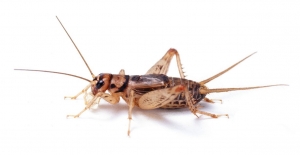 Origin: Apparently native to Europe, but introduced to North America in the 18th Century.
Origin: Apparently native to Europe, but introduced to North America in the 18th Century.
Biology: These crickets are found outdoors as commonly as indoors, and are sold in stores for pet food, fish food, or live bait for fishing. They are a nuisance indoors due to their habit of chewing on fabrics, often chewing large holes in clothing. They attack all types of material, and often it is synthetic fabrics that are most damaged, although cotton, wool, and silk are attacked as well. They also may feed on food materials such as baked goods, as well as chewing on paper products. They even feed on other insects, dead or alive. Females appear to be prolific, producing an average of 730 eggs. In outdoor environments they may place them in the soil, and in structures may place them in cracks and crevices. The eggs hatch within 2 to 3 months, and the nymph stages complete in around 2 months.
Millipede
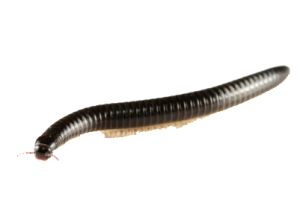 Origin: These are primarily native to North America, and they occur throughout the United States.
Origin: These are primarily native to North America, and they occur throughout the United States.
Biology: Millipedes are slow moving vegetarians, feeding on both decaying vegetation as well as live plant tissues. They are essentially harmless to humans in North America, while some species in South America are able to exude a cyanide-like spray from their bodies when disturbed. North American species do exude an unpleasant smelling secretion, and they also may lose body fluids as they die, causing staining on indoor surfaces. The secretion is a combination of irritating chemicals that may cause skin rashes on people and even be toxic to small animals. The larger species are capable of living up to 8 years, sometimes requiring up to 5 years to reach sexual maturity. Eggs are laid in the soil in batches of from 20 to 300 eggs, and newly emerged nymphs are very small with only around 7 body segments and only 3 pairs of legs. As they grow they add more sections and legs. In addition to the foul odor they can give off, millipedes protect themselves by rolling into a tight coil when disturbed, protecting the more vulnerable ventral parts.
Pocket Gopher
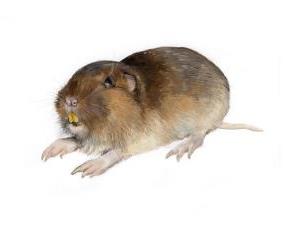 Origin: There are 35 species of gophers, in 5 different genera, in North America, extending from Canada throughout Central America. They are native animals in North America.
Origin: There are 35 species of gophers, in 5 different genera, in North America, extending from Canada throughout Central America. They are native animals in North America.
Biology: Gophers lead a subterranean life (called fossorial) in meandering burrows they dig with their teeth and front legs. They are active above ground only when young are leaving their mother’s burrow system or when males seek females for mating. Except for these two times gophers are aggressively solitary animals. They are vegetarians, feeding primarily on plant roots and tubers. Gophers do not hibernate, and will be active year-round, although activity in hot weather is minimal and is high in spring and fall. In most natural areas there is a single litter per year, with 5 to 6 young per litter.
Silverfish and Firebrat
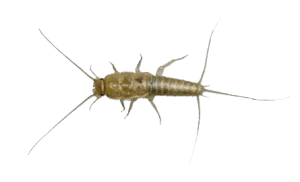 Origin: Not known for certain, but for both species it is believed their origin is a tropical country. They are found worldwide, and have been for so long that their origin is now unknown.
Origin: Not known for certain, but for both species it is believed their origin is a tropical country. They are found worldwide, and have been for so long that their origin is now unknown.
Biology: These are primitive insects that undergo simple metamorphosis, molting as much as 50 times before reaching the adult stage. The development to the adult stage can be anywhere from a few months to as long as 3 years, depending on the conditions it is living in. They generally live for several years. Both species feed on a wide variety of materials, including human foods, paper products, fabrics, or glue in books and wallpaper. They are common outdoors in woodpiles or fences. The firebrat is so named because it prefers a habitat of higher temperatures, preferably above 90 degrees, and they may be common in attics in the summer. These insects are both covered with scales, they are flattened from top to bottom, and are able to squeeze into tiny cracks to hide or to gain entry.
Vole
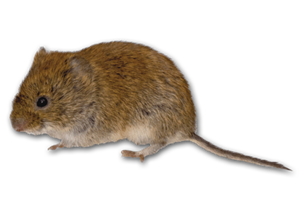 Origin: At least 84 species in this genus, with Microtus pennsylvanicus most prevalent east of the Rocky Mountains and north into central Alaska, and M. californicus most common in the western states. These are native animals.
Origin: At least 84 species in this genus, with Microtus pennsylvanicus most prevalent east of the Rocky Mountains and north into central Alaska, and M. californicus most common in the western states. These are native animals.
Biology: Favored foods are fresh foliage and flowers in the warm months, seeds and grains in cold months, or even the bark of young plants and trees in the winter. Voles may be very destructive to grain and vegetable crops. Nesting is done is burrows in shallow soil or in thick grass and vegetation, and distinct runways are created above ground as the mice travel and forage. Breeding can be done year round, with the highest activity from March until November, and mating takes place immediately following the birth of a litter. There is an average of around 6 young per litter, and the potential exists for a breeding pair beginning in the spring to result in almost 3000 mice by the fall. There can be up to 10 litters per year, and population explosions result about every 4 years.
Wasp
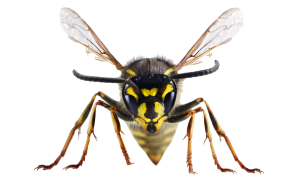 Origin: There are many species of Vespula in North America, including several species introduced from Europe. Two of these, Vespula germanica and Vespula vulgaris, are among the serious scavenger pests in this group.
Origin: There are many species of Vespula in North America, including several species introduced from Europe. Two of these, Vespula germanica and Vespula vulgaris, are among the serious scavenger pests in this group.
Biology: Yellowjackets are social wasps, with a Queen that initiated the colony and female workers that build the nest, care for the young, forage for food, and defend the colony. Colonies typically begin each spring and die off each fall in cooler climates, but may survive over the winter in warmer climates. The population of the colony easily grows to many thousands of workers by the end of the summer, at which time males are produced, mating with new queens takes place, and these fertilized queens then over-winter in protected locations. Adults feed on sweet liquids such as honeydew, nectar, fruit juices, or human foods such as sodas. They also relish a sugary material exuded by the larvae. The larvae are fed meat, and natural sources are insect larvae or bits of flesh from dead animals. As scavengers the workers also gather human foods at outdoor eating areas. The workers are all able to sting repeatedly, and very aggressively defend their colony from perceived intruders. Nests are placed either in aerial locations, including trees, shrubs, wall voids, or attics, as well as in the ground, where workers enlarge holes they to accommodate the growing colony. The nest is created from cellulose gathered from tree bark, dried plant materials, or other sources, mixed with saliva, and formed as the hexagonal cells for the larvae.
